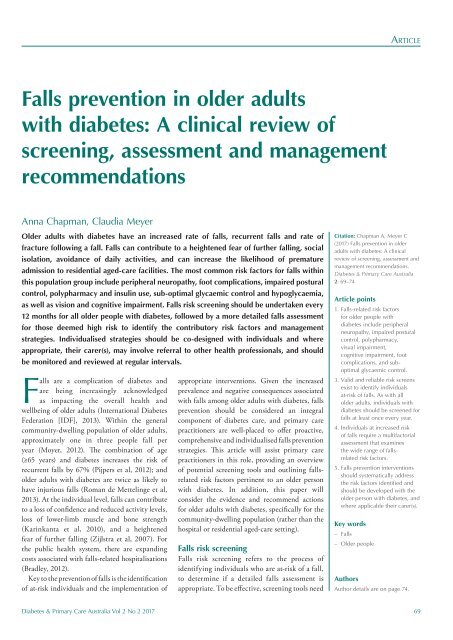DPCA2-2_issue_v3
You also want an ePaper? Increase the reach of your titles
YUMPU automatically turns print PDFs into web optimized ePapers that Google loves.
Article<br />
Falls prevention in older adults<br />
with diabetes: A clinical review of<br />
screening, assessment and management<br />
recommendations<br />
Anna Chapman, Claudia Meyer<br />
Older adults with diabetes have an increased rate of falls, recurrent falls and rate of<br />
fracture following a fall. Falls can contribute to a heightened fear of further falling, social<br />
isolation, avoidance of daily activities, and can increase the likelihood of premature<br />
admission to residential aged-care facilities. The most common risk factors for falls within<br />
this population group include peripheral neuropathy, foot complications, impaired postural<br />
control, polypharmacy and insulin use, sub-optimal glycaemic control and hypoglycaemia,<br />
as well as vision and cognitive impairment. Falls risk screening should be undertaken every<br />
12 months for all older people with diabetes, followed by a more detailed falls assessment<br />
for those deemed high risk to identify the contributory risk factors and management<br />
strategies. Individualised strategies should be co-designed with individuals and where<br />
appropriate, their carer(s), may involve referral to other health professionals, and should<br />
be monitored and reviewed at regular intervals.<br />
Falls are a complication of diabetes and<br />
are being increasingly acknowledged<br />
as impacting the overall health and<br />
wellbeing of older adults (International Diabetes<br />
Federation [IDF], 2013). Within the general<br />
community-dwelling population of older adults,<br />
approximately one in three people fall per<br />
year (Moyer, 2012). The combination of age<br />
(≥65 years) and diabetes increases the risk of<br />
recurrent falls by 67% (Pijpers et al, 2012); and<br />
older adults with diabetes are twice as likely to<br />
have injurious falls (Roman de Mettelinge et al,<br />
2013). At the individual level, falls can contribute<br />
to a loss of confidence and reduced activity levels,<br />
loss of lower-limb muscle and bone strength<br />
(Karinkanta et al, 2010), and a heightened<br />
fear of further falling (Zijlstra et al, 2007). For<br />
the public health system, there are expanding<br />
costs associated with falls-related hospitalisations<br />
(Bradley, 2012).<br />
Key to the prevention of falls is the identification<br />
of at-risk individuals and the implementation of<br />
appropriate interventions. Given the increased<br />
prevalence and negative consequences associated<br />
with falls among older adults with diabetes, falls<br />
prevention should be considered an integral<br />
component of diabetes care, and primary care<br />
practitioners are well-placed to offer proactive,<br />
comprehensive and individualised falls prevention<br />
strategies. This article will assist primary care<br />
practitioners in this role, providing an overview<br />
of potential screening tools and outlining fallsrelated<br />
risk factors pertinent to an older person<br />
with diabetes. In addition, this paper will<br />
consider the evidence and recommend actions<br />
for older adults with diabetes, specifically for the<br />
community-dwelling population (rather than the<br />
hospital or residential aged-care setting).<br />
Falls risk screening<br />
Falls risk screening refers to the process of<br />
identifying individuals who are at-risk of a fall,<br />
to determine if a detailed falls assessment is<br />
appropriate. To be effective, screening tools need<br />
Citation: Chapman A, Meyer C<br />
(2017) Falls prevention in older<br />
adults with diabetes: A clinical<br />
review of screening, assessment and<br />
management recommendations.<br />
Diabetes & Primary Care Australia<br />
2: 69–74<br />
Article points<br />
1. Falls-related risk factors<br />
for older people with<br />
diabetes include peripheral<br />
neuropathy, impaired postural<br />
control, polypharmacy,<br />
visual impairment,<br />
cognitive impairment, foot<br />
complications, and suboptimal<br />
glycaemic control.<br />
3. Valid and reliable risk screens<br />
exist to identify individuals<br />
at-risk of falls. As with all<br />
older adults, individuals with<br />
diabetes should be screened for<br />
falls at least once every year.<br />
4. Individuals at increased risk<br />
of falls require a multifactorial<br />
assessment that examines<br />
the wide range of fallsrelated<br />
risk factors.<br />
5. Falls prevention interventions<br />
should systematically address<br />
the risk factors identified and<br />
should be developed with the<br />
older person with diabetes, and<br />
where applicable their carer(s).<br />
Key words<br />
– Falls<br />
– Older people<br />
Authors<br />
Author details are on page 74.<br />
Diabetes & Primary Care Australia Vol 2 No 2 2017 69
















